Designing inclusive cities
Hassnae Bouazza
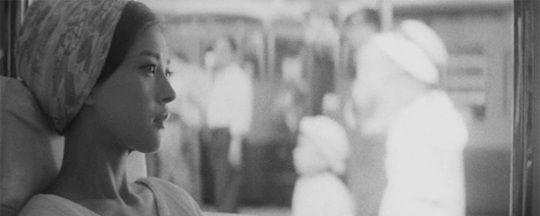
Mariko Okada in Woman of the Lake (Yoshishige Yoshida, 1966). Source: Lipstick Trouble
Shahira Fahmy was a young and influential Egyptian architect before choosing acting as a career. She now stars alongside Isabelle Hupert in Claire’s Camera, directed by Hong Sang Soo. She says in this video clip that she doesn’t know how architecture lead her to acting.
Let me take a guess: in designing, you try to make a better world. More beautiful, more comfortable, you also try tell a story. Each design, building, concept has its own story to convey. You make people’s lives easier, you give them freedom, a place to repose, you emancipate them. In acting you also tell stories, stories that people can relate to, you lift the lid on taboos, visualise delicate subjects, you celebrate stories – and you create beauty.
When I was thinking about this lecture I had a zillion thoughts and ideas and the challenge was to structure them. I had a long talk with Design as Politics’ Professor Wouter Vanstiphout in preparing this talk and what at first seemed like a dare, namely link emancipation and feminism to design, very quickly became very obvious. But of course design and feminism are not only linked but intertwined. If you think about it, everything connected to progress has inevitably to do with emancipation and feminism, be it vacuum cleaners, big supermarkets, take away meals, that make people’s lives easier and give women in more traditional societies room for a career – to buildings that take into account the needs of the modern female. Let me give you an example.
Public toilets
Last week a judge ruled in a very interesting case a young lady had filed: it was 2015, after hours, she had to pee, couldn’t find a toilet, and decided to pee in a corner on the street. A police man saw her, but of course he did, police men never miss an opportunity to squeeze money out of people, fined her and she decided to fight the fine, reasoning that she didn’t have a choice, because of the lack of public toilets for women. There are plenty of urinals, but no decent places for women to go and relieve themselves. The judge acknowledged there are few public toilets for women, but that’s ‘because men tend to urinate in public more often’, he ruled that she should have used a urinal.
So the logic is this: men break the law by urinating in public and the state rewards them by providing urinals. I’m sure you know what those urinals look like: stinky, dirty. I always imagine the stench when I walk past one and keep my distance.
Urinals were designed for the comfort of men. An acknowledgment of the idea that a man has to do what a man has to do. So what about women? Why is it perfectly normal to find urinals in city centers, but do city councils just assume women don’t need toilets? Which of you smart minds will be able to think of a solution that is so much more appealing than the few public toilets we have now and which I for one avoid at all cost. So, who will help out the modern day woman and design an attractive, clean solution for her.
White feminists
It may sound silly, but it is a matter of principle. Why aren’t there facilities both for men and women? Emancipation and feminism is not only about the big issues, but maybe more about the smaller details that people tend to forget or ignore, because of the very fact that they appear minor. I think that’s where we’re at at the moment. Many feel that the struggle has been won and we can lay back.
But that’s when it becomes interesting and I think these are very interesting times for feminists and activists, because in order to achieve even more really meaningful results, you will need new alliances and solidarity. But solidarity is quite an obstacle since the interests of various groups and individuals differ. Let’s take certain white feminists, for instance. Feminism used to be something rebellious, feminists fought the powers, turned against governments, women were brazen en disobedient, but here in the West, and Holland, quite a few of the feminists have become part of the elite and now turn against those who do not play by their rules, by wearing a headscarf, for instance, or by not working 40 hours a week.
One very clear example. There is this racist sexist website, GeenStijl, which has been making victims for the past ten years by posting intimate videos of people, harassing others with a camera, publishing racist crap, and it never hurt them. They became bigger and bigger and were embraced by the establishment, even the political elite.
Ignoring women of colour
But then a while ago they were criticised for their sexism by white female journalists upon which this website turned on them and for the first time people became vocal. They finally noticed the sexism and denounced it. There was even a petition of over a hundred female professionals calling upon companies not to advertise on the site. I was one of the women who were asked to sign the petition and I did so on the condition they would change the text: sexism and racism had been running rampant on that site for years, not just recently when white women were targeted. Ignoring the other victims, women of colour, black people, muslims, homosexuals, was unacceptable for me and a few of the other women. The fact that people only noticed the reprehensible contents of the site when white women addressed it, says something about the position non-white people have.
So now there is a group of activists who are trying to establish a more intersectional and inclusive base to be more effective and influential. To do so, you have to think outside of your own box and show a little empathy.
A few weeks later one of the leading women behind the petition, Rosanne Hertzberger, criticised identity politics, by claiming there are more urgent issues to solve. But the simple truth is: everything is identity politics, or as Naomi Klein writes in het latest book No is not enough.
Stealing land
The ability to discount darker people and darker nations in order to justify stealing their land and labor was foundational, and none of it would have been possible without those theories of racial supremacy that gave the whole morally bankrupt system a patina of legal respectability. In other words, economics was never separable from “identity politics,” certainly not in colonial nations like the United States—so why would it suddenly be today?
I thought it was a pity. Hertzberger relied on the support of other women but was too selfish to show some reciprocity.
For me emancipation and feminism are not only about my own struggle, but about equality for all regardless of background, colour, religion, sexuality, you name it. And I want to share some seemingly superficial examples with you that -in my view- help emancipation and progress.
Macho Arabs
This is one of my favourite clips that I like to share, because it says so much:
We see here the demolition of the macho Arab man. Western people who see this are suprised, because they see cheerful Arab people creating something beautiful, having fun, doing something they do here as well.
Arabs see role models interacting in a very relaxed way, they see ambitious young people dreaming of fame and they see men not afraid to show their emotions. And a man who is not to afraid to show his vulnerability. This clip is so important because it shatters prejudices on all sides and in so many ways. There’s more to tell you about it, but I want to show you another clip:
I like this one as well. These men did what Hertzberger couldn’t bring herself to do: show solidarity and stand up for women. Five years old but still very relevant, because the question remains: how do we make cities safer for women -and everyone else. Maybe you have some ideas about this.
Macho Arabs
I know in Germany they have special parking spaces for women that are extra lit in parking garages. In countries like Japan and the Emirates metro’s and trams have special compartments that are exclusively for women. It may sound like sexual segregation, but really when I was in Dubai I used those compartments, it felt nice and safe.
Now let’s go back to this story of the urinals, when you think about it, everything is designed from a male perspective. Because men are still largely in charge. The parking spaces, the train compartments, they’re exceptions. I understand over fifty percent of the student population is female but as you go to the top, the women disappear. But if you want to push change, you’ll have to break that glass ceiling, hang in there and create alternatives, safe spaces, onorthodox neighbourhoods and buildings that help people develop themselves and find their freedom.
Praying women
Let’s take a look at a concrete example from Istanbul, the Cakirin mosque, designed by a woman with the interest of women in mind.
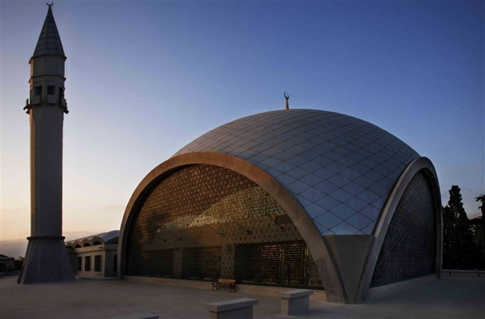
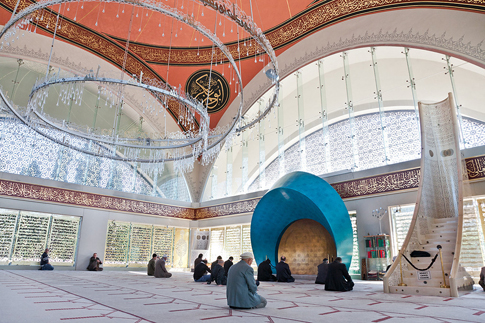
It’s a very spacious and light design, windows everywhere. And the women don’t sit at the back like in most mosques, but on sort of a balcony on the first floor, in that way they have a view, but they are also higher than the men who pray on the ground.
In the islamic world there is this ongoing discussion about where women pray. In most mosques at the back, so as not to mingle with men. But in Mecca and Medina, the two most holy of islamic sites, women and men pray together.
There is a female run mosque in Copenhagen, the Mariam Mosque, but it has no special design. It’s just a very small space in a building that blends in with the rest.
Phallic buildings
If we look at the unease in certains part of society and politics with islam, one could think of a building that oozes modernity and beauty and at the same functions as a spiritual place of worship where men and women are equal. A mosque that doesn’t instill fear but is inviting and intruiging. One that challenges the status quo of architecture with soft, round features.
Something like this, the Al Whakrah stadium, designed by Zaha Hadid:

I’m sure you all remember the discussion about this stadium, right. It looked like a vagina. But you never hear any one talk about those big phallic symbols that confirm male dominance.
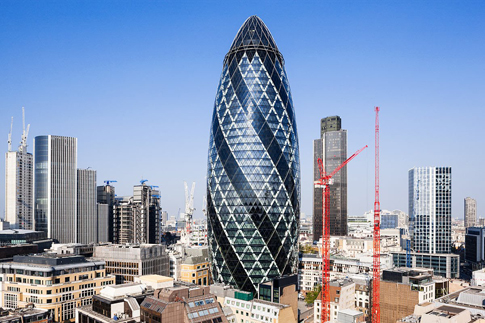
Those penises of buildings designed to attract and dominate. Standing tall above the rest. There’s even a competition of who has the biggest, tallest, baddest.
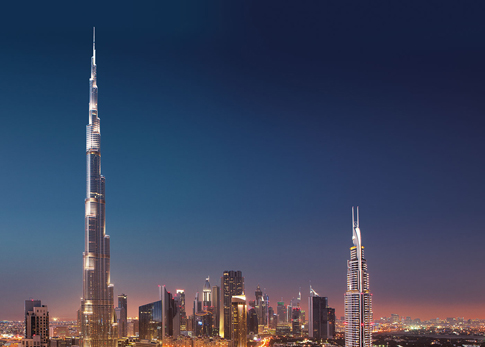
Dubai is running on top at the moment. They keep on building them. Just the other day a tape resurfaced of Donald Trump just after 9/11: he didn’t speak of the awful tragedy that had just taken place, but that now that the Twin Towers had collapsed, his Trump tower was the tallest building. How sad. #sad
Neighborhoods for everybody
What we see around us, helps shape our view of the world. If poor people live in designated areas, we start to see them as the others. If poor people are dark skinned, we will start to link social and economic class to skin colour and culture. Governments tend to segregate classes, but the fact is they like to keep poor people as far away from the rest as possible.
But what if we challenge this idea of social and economic segregation. What if we build cities and neighbourhoods that offer a space for everybody regardless of colour or bank account? Cities and neighbourhoods where people can mingle, develop themselves, grow, emancipate and climb the social ladder? Neighbourhoods where women, and hence everybody, feel safe.
What would it take? Affordabe buildings next to luxurious apartments. Shops that cater to everybody’s need, centres that welcome everybody, cinemas that run blockbusters and obscure films, theatres with plays and concerts, streets that are well lit at night, so nobody’s afraid.
I believe in the power of the encounter. I believe emancipation and feminism mean equality for all. And how do you learn to see the other as your equal? By meeting him or her, seeing him or her, accepting him or her. Learning and knowing that the other is a mirror of yourself. By realising that we are all connected and we all share certain universal values. Bring people together, and you will be able to change the world. That may sound naive and idealistic, but it takes a small group of idealists to change the world.

The women’s movement did it by fighting for equal rights for women. Martin Luther King and Malcolm X did it. James Baldwin as well.
Words can change the course of history. Just take a look at Donald Trumps Twitter account and you know what I mean. Design can change the course of history. It can help create equality, without ever compromising on the artistry or creativity of the designer.
Palestinian refugee camp
Another example. Take a look at this. What do you think this is:

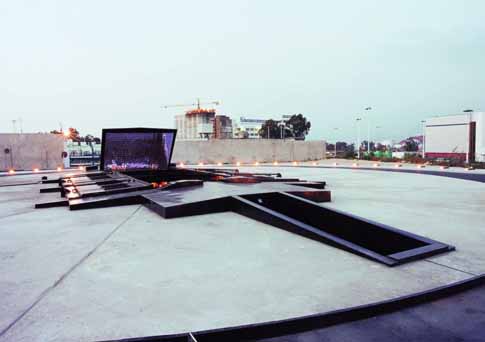
This is an underground club just outside of Beirut. Its owner Naji Gebran believed in music as therapy in war torn Beirut of the 80’s. He organized dance parties that were very popular. In 1998 he asked architect Bernard Khoury to build a new home for the club, in a neighbourhood that had witnessed atrocities during the war. It is said that there used to be a Palestinian refugee camp on that plot of land.
Khoury integrated elements from the war in his design that has been labeled war architecture. This club B 018 has become a safe haven for gays, liberals, everybody who wants to dance and have a good night out. It’s a place where you can be yourself and forget the misery -even though everything about the building reminds you of it.
American rapper
Like I said, buildings that ooze modernity and beauty, that intruige, that are inviting. Imagine building something for refugees. A place where they can escape the horrors of war, where they can feel welcome, instead of depressed because of the dismal atmosphere most asylum centers have now.
Imagine designing neighbourhoods where people regardless of class can enjoy a healthy, safe environment. Where they don’t feel caged like in the depressing banlieues or the Projects in the States. Years ago I interviewed an American rapper and he spoke of the Projects where poor, mainly black people live. Big flats that breathe contempt for human life. And he said: “they even call those hoods ‘projects’, see, we’re a project to them. An experiment.”
If you seclude people, if you exclude them from your society, from your environment, don’t be surprised when they turn their backs on you as well. We’ve seen it in France where an alarmingly high number of young people don’t feel any connection whatsoever with society. A few years back I was in one of those derilict neighbourhoods in Dijon -not even Paris, where it’s worse. I was just shocked people could live there. The ruinous flats, the decay.
Asylum seekers
The same goes for centres for asylum seekers. They’re always outside the towns, with this clear message: they don’t belong there, they don’t belong in the city.
What if we change that? How about integrating the other when designing, so that the other is no longer the other, but one of us?
How about designing cities that challenge the political perceptions of reality. Cities that reflect our daily lives, which are so much more nuanced and layered than politicians would have us believe with their cheap lines?
Because that’s another thing: if we follow the debate and the media, you would almost think we’re on the brink of collapse, whereas in reality, historically speaking these are relatively very wealthy and peaceful times.
So, the title of this series is design as politics, but the truth is design is politics. And you have a chance to influence politics and to influence reality. Start with reality and politics will have no other option but to follow.
This is a lecture held last week as part of the Design as Politics project by the Delft University. Hassnae Bouazza is a Dutch-Moroccan writer, journalist, Middle-East watcher and translator. She received the Arouwad Award in Beirut in 2015 for her work on the Arab world. Dutch islamophobes consider her a front soldier of the islamisation of The Netherlands. Together with former MP Femke Halsema she made a documentary series about women in the islamic world, Sex and Sin.
English, Hassnae Bouazza, 01.10.2017 @ 12:44
1 Reactie
op 01 10 2017 at 13:34 schreef Martijn:
Thanks for this, it’s aways great to see what’s going on in the world without the myopic view of “the news”. I follow Arabic music a bit and get some peeks into a more complete “Arabic world”: from Mashrou’ Leila, Ramy Essam’s new album, the great new video by Zahzah x Khansa and Myriam Fares subtly taking on a Lady Gaga-like role in her latest video.
I also recommend “Show Me A Hero”, David Simon’s (The Wire, The Deuce) short series about the “projects”.

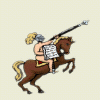
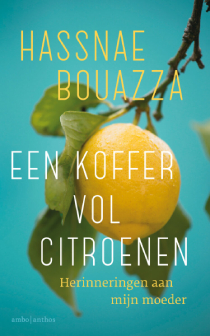
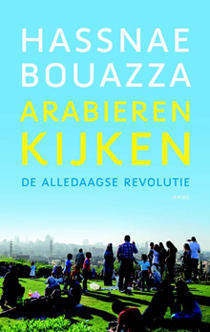
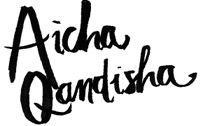
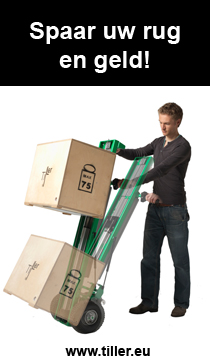
 RSS
RSS